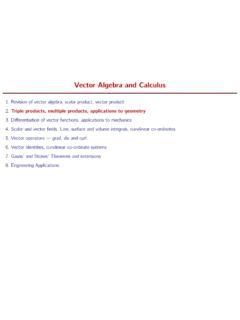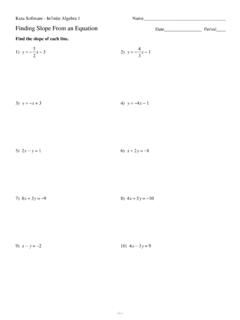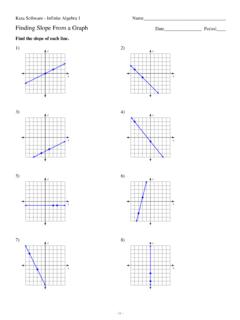Transcription of Partial Differential Equations & waves
1 Partial Differential Equations & waves Professor Sir Michael Brady FRS FREng Michaelmas 2005. Analysing physical systems Formulate the most appropriate mathematical model for the system of interest this is very often a PDE. Diffusion of charge, flow of heat, absorption of a drug Propagation of waves across water, electrical networks, with/without loss of energy steady state no further change in stress analysis, heat or fluid flow, . Figure out the appropriate boundary conditions, apply them We will recall from ODEs: a single equation can have lots of very different solutions, the boundary conditions determine which Solve the PDE. In this course, solutions will be analytic = algebra & calculus Real life is not like that!! Numerical solutions include finite difference and finite element techniques This is what a large part of Engineering science & practice is about. but why Partial Differential Equations A physical system is characterised by its state at any point in space and time u ( x, y, z , t ), temperature in here, now u State varies over time: t 2u State also varies over space: things like x y Surely, we need to relate these variations to each other u u 2.
2 =k 2. t x How do we relate spatial variations to temporal variations? Constituent Equations which you met in vector calculus embody physical constraints such as conservation of mass , conservation of enthalpy . In the case of an insulated, diffusing distribution of heat, the equation (which we will derive later) is: u 2u 2u 2u . = k 2 + 2 + 2 . t x y z . That is, the spatial change is directly proportional k to the temporal change Don't panic! We'll work mostly in one spatial dimension An example of a PDE: the one-dimensional heat equation u 2 u 2. =c t x 2. K. In this case : c =. 2.. K = thermal conductivi ty = specific heat = density of the material Another example: the one-dimensional wave equation u 2. 2 u 2. = c t 2. x 2. T. In this case : c 2 =.. T = tension in the string = mass/unit length of the string Background to this course Partial differentiation Electrical Ordinary Differential engineering Equations Partial Differential Equations Mechanical Fourier series engineering Numerical methods Civil engineering Vector calculus Biomedical We now give brief reminders of Partial differentiation, ODEs, and Fourier series.
3 Please re-read the engineering relevant parts of Kreysig if you are shaky on some particular part Partial derivatives*. Consider the function : u ( x, y ) = a ( x y ) + cxy + d 2 2. u Partial derivative with respect to x : = 2ax + cy x u Notation : ux x From which: u xx = 2 a u xy = c * Please refer to Kreysig, 8th Edition, pages A57 A60 for a refresher Partial differentiation with respect to y u ( x, y ) = a( x 2 y 2 ) + cxy + d u y = 2ay + cx u yy = 2a u yx = c Evidently, changing the order of differentiation makes no difference: u u . = . y x x y . This is the case whenever u varies smoothly with respect to x and y. This is almost always so. Chain rule*. Suppose that we are given a function C (u , v). where u = u ( x, y ) and v = v( x, y ). C C. The total variation in C is dC = du + dv u v From which we find C x = Cu u x + C v v x C y = Cu u y + C v v y *Kreysig, 8th Edition, page 444. Ordinary Differential Equations dy First order + ay = 0 y = Ae ax dx Kreysig, 8th Edn, pp 19-21.
4 D2y dy Second order* a 2. + b +c=0 am 2 + bm + c = 0. dx dx Auxiliary equation Case 1: real, unequal roots 1 , 2 y = Ae 1x + Be 2 x Case 2 : real, equal roots y = ( Ax + B)e x Case 3 : complex roots a j y = e ax ( A cos x + B sin x). *Kreysig, 8th Edn, Chapter 2. Homogeneous Equations : superposition of solutions The terms on the left side of : y ' '+ p ( x) y '+ q ( x) y = r ( x). contain the unknown function y ( x) or one of its derivative s. If r ( x) = 0, the ODE is then called homogeneou s Fundamental theorem* about homogeneous ODEs: if y1 ( x) and y2 ( x) are solutions to a given ODE, then c1 y1 ( x) + c2 y2 ( x) is also a solution, where ci are constants. More generally, any linear superposition of solutions c y ( x). i i i is a solution. *Kreysig, 8th Edn, p66. How we use superposition of solutions d2y Consider: 2. ky = 0 where k can be +ve, -ve, 0. dx x x k > 0, say k = 2. y = Ae + Be k =0 y = Cx + D. k < 0, say k = 2. y = E cos x + F sin x We superpose these solutions, and leave it to analysis of the boundary conditions to help us figure out which bits are relevant in any given case y = ( Ae x + Be x ) + (Cx + D ) + ( E cos x + F sin x ).
5 X For example, if we are told: y 0, as x , then y = Be Partial Differential Equations generally have many different solutions Recall the function we used in our reminder of Partial derivatives: u ( x, y ) = a ( x 2 y 2 ) + cxy + d This choice was not random! Recall that we showed: 2u 2u = 2a and = 2a x 2. y 2. Evidently, the sum of these two is zero, and so the function u(x,y) is a solution of the Partial Differential equation: u u 2 2. + 2 =0 Laplace's Equation x 2. y A completely different solution to Laplace's Equation Consider the entirely different function: v ( x , y ) = e y cos x 2v y We find = e cos x x 2. and 2v y = e cos x y 2. 2v 2v So that the function v(x,y) also satisfies + 2 =0. x y 2. Evidently, by superposition : u ( x, y ) + v( x, y ) is also a solution Boundary conditions determine the solution in any particular case Showing that particular functions satisfy particular PDEs is the subject of Q1, Q2 on the first tutorial sheet An example of applying specific boundary conditions Consider the superposition of the two solutions u(x,y)+v(x,y).
6 Suppressing constants, which would make no difference: u ( x , y ) = Ae y cos x + B( x 2 y 2 ) + Cxy + D (1). And, suspending reality for a moment, suppose this represents the stress in an infinite plate with a circular hole: y x F F. By considering x and y at infinity, it is clear that for (1) to be a physically plausible solution, then because the stress must remain finite, we conclude that B = C = 0. How Fourier series enter the game Anticipating lecture 2, suppose we are solving a specific case of the Heat Equation, to find the temperature of a bar of length L. We will find that the solution is given (in that case) by the temperature kq 2t T ( x, t ) = Ae sin qx Applying the problem-specific boundary condition that the end of the bar (x=L) is maintained at zero temperature, we have A sin qL = 0, so that A = 0 or sin qL = 0.. We are not interested in the first of these, so qL = n , that is : q = n L. Every value of n corresponds to a solution, so we use superposition to find the general solution: kn 2 2.
7 T . n x We then apply Fourier series T (x,t) = . n=0. Ane L2 . sin L to solve for the An Fourier series* in 3 steps 1. Fourier theory asserts that for any periodic function, f( ), with period 2 , coefficients an and bn can be found such that . f ( ) = an cos n + bn sin n . n =0 n =1. 2. Many functions of interest are not specified as periodic; but they can be made so by judicious choices T T. To T0. x x . = . L - T0 L . 3. To find the constants an and bn, we proceed in one of two ways: a. Look up the solution in HLT. b. Figure them out from first principles using orthogonality relations . We'll do both in the next lecture *Kreysig, 8th Edn, Sections , p526. A page scanned from HLT. How to apply orthogonality relationships . Suppose we are told that : f ( ) = an cos n + bn sin n . n =0 n =1. The orthogonality relationships massively simplify finding the coefficients. We first multiply the function f( ), by cosm and integrate between 0 and 2 . 2 2 2 . f ( ) cos m d =.
8 1 1 1. 2 . 0 2 . 0 n =0. an cos n cos m d +. 2 . 0 n =1. bn sin n cos m d . Reversing the orders of summation and integration on the right hand side gives 2 2 2 . f ( ) cos m d =. 1 1 1. 2 2 .. n =0. an cos n cos m d +. 2 .. n =1. bn sin n cos m d . 0 0 0. This is zero unless m=n This is always zero 2 2 . f ( ) cos m d =. 1 1 am giving 2 . 0. 2 . 0. am cos m cos m d =. 2. 2 2 . f ( ) cos m d =. 1 1 am giving 2 0. 2 . 0. am cos m cos m d =. 2. so 2 . f ( )cos m d . 1. am =. 0. Similarly, 2 . f ( ) sin m d . 1. bm =. 0. These are the coefficients for the full-range series, ie those for which 0 < < 2 . Orthogonality relationships also hold for half-range series (ie those for which 0. < < ) which are also useful. They are . f ( ) cos n d f ( ) sin n d . 2 2.. an = bn =. 0 0. Three Equations dominate Diffusion (or heat) equation Diffusion problems, transient heat 1 u u2. = 2 transfer, concentration in fluids, t x transient electric potential Laplace's (or potential) equation 2u 2u + 2 =0 Steady state problems in stress x 2.
9 Y analysis, heat transfer, electrostatics, fluid flow .. Wave Equation u2. 2 u 2. Wave phenomena in mechanical =c systems (vibrations), fluids, t 2. x 2. electricity .. The general second order PDE. A( x, y )u xx + B ( x, y )u xy + C ( x, y )u yy +. D( x, y )u x + E ( x, y )u y + F ( x, y )u = G ( x, y ). Elliptic, if B 4 AC <0. 2. Laplace Parabolic, if B 2 4 AC = 0 Diffusion Hyperbolic, if B 4 AC > 0. 2 Wave The three PDEs arise most frequently in practice, and they cover the most interesting basic PDEs Overview of the Course 1. General introduction, revision of Partial differentiation, ODEs, and Fourier series 2. Wave equation in 1D part 1: separation of variables, travelling waves , d'Alembert's solution 3. Heat equation in 1D: separation of variables, applications 4. limitation of separation of variables technique. Sometimes, one way to proceed is to use the Laplace transform 5. Laplace's equation: first, separation of variables (again), Laplace's equation in polar coordinates, application to image analysis 6.
10 Wave equation in 1D part 2: phase and transverse velocity, characteristic impedance, wave number, circular fequency, standing waves ; impedance boundaries, lossy (dispersive) waves , amplitude modulation 7. Water waves 8. Another look at separation of variables: Sturm-Liouville Equations and orthogonal functions. Legendre and Bessel functions. Moral of the tale: read the notes AND. Books Kreysig. K has more detail, fewer jokes 1. Kreyszig Advanced Engineering Mathematics 8th Edition. Very big, impresses fellow students, mostly unread but can support a stereo or three pints. Most of the course follows the treatment in this book. 2. James: Advanced Modern Engineering Mathematics. Again comprehensive, perhaps a bit easier than Kreyszig. Somewhat duller and less impressive for your tutor. 3. Main Vibrations and waves in Physics. Used, with James for waves section. Unlikely that your tutor will believe that you bought it, or even read it. 4. Pain The Physics of Vibrations and waves , ditto Main.















